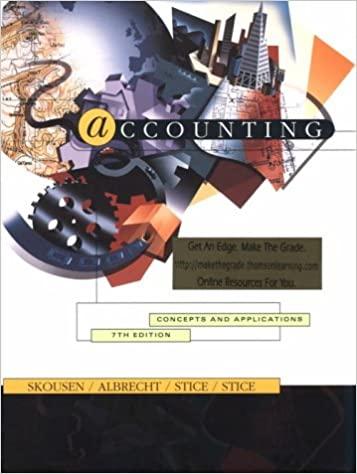Question
Create a table to determine the annual tax effects (increase or decrease to taxes paid) if they decide to purchase the new machine. A) Assume
| Create a table to determine the annual tax effects (increase or decrease to taxes paid) if they decide to purchase the new machine. | |||||||||
| A) Assume a tax rate of 40% | |||||||||
| B) Depreciate assets based on the information in the case (do not use MACRS). | |||||||||
| C) Identify and label each adjustment to taxable income, don't just present the net increase/ decrease for each year. | |||||||||
Existing Machine
The existing machine was a Matrix 750. The Matrix had been purchased secondhand when it was five years old. Davidson was particularly concerned with staff safety and was reluctant to allow other staff members to use this machine because this particular model was known to be very sensitive to the angle of the timber and would kick back severely if the lumber was not correctly positioned. Davidson had not experienced this particular problem since owning the machine.
A competitor had offered $35,000 cash for the machine, an amount that represented its current book value. If Davidson opted to keep the machine, Magic would continue to claim depreciation of $6,000 per year for each of the next five years, at which point the machine would be unserviceable and would be sold for $5,000 as scrap. If Davidson elected to keep and repair the old machine, it would require $28,000 to be spent immediately and $7,000 in regular maintenance in each of the next five years. In Year 3, the machine would require another investment of $4,000 for a larger scheduled service.
New Machine
The new machine under consideration was a Delta A390, which offered an increase in capacity of 40 per cent. This capacity was probably in excess of Magics needs, although the business would make some use of it. Also, the new machine allowed the possibility of obtaining some custom work for a specialist woodcrafter.
The new machine cost $140,000, and the tax office allowed straight line depreciation of 10 per cent per annum. After five years, Magic would sell the Delta for $60,000. Given that the company selling the machine to Magic operated in a very competitive market, it was willing to negotiate on the terms of a maintenance plan. The seller offered fixed pricing starting at $2,000 in the first year, increasing by $1,000 per year (payable at year end). To fund the purchase, Magics bank offered a 6 per cent per annum loan to be repaid as interest-only payments for five years, with the full principal repayable at the end of the loan period.
Given the technological advancements of the Delta over the Matrix, Davidson expected that he could achieve significant savings in both labour and electricity costs. For labour, in the first year, Davidson forecasted a 10 per cent cost reduction (the existing rate was $30 per hour), based on a 35-hour week in a 50-week year. This labour saving would then increase by a fixed $250 each year.
For electricity, in the first year, the saving was expected to be 10 per cent as well. Electricity costs averaged
$5.625 per hour, 24 hours a day, seven days a week, in a 50-week year. This electricity saving would then increase by a fixed $75 each year.
Step by Step Solution
There are 3 Steps involved in it
Step: 1

Get Instant Access to Expert-Tailored Solutions
See step-by-step solutions with expert insights and AI powered tools for academic success
Step: 2

Step: 3

Ace Your Homework with AI
Get the answers you need in no time with our AI-driven, step-by-step assistance
Get Started


